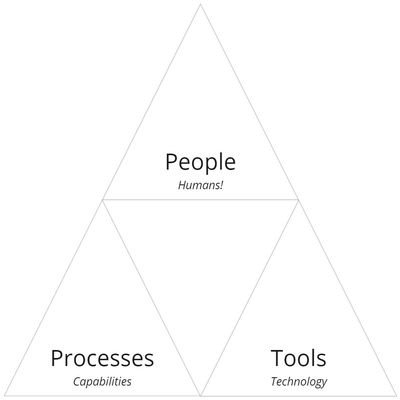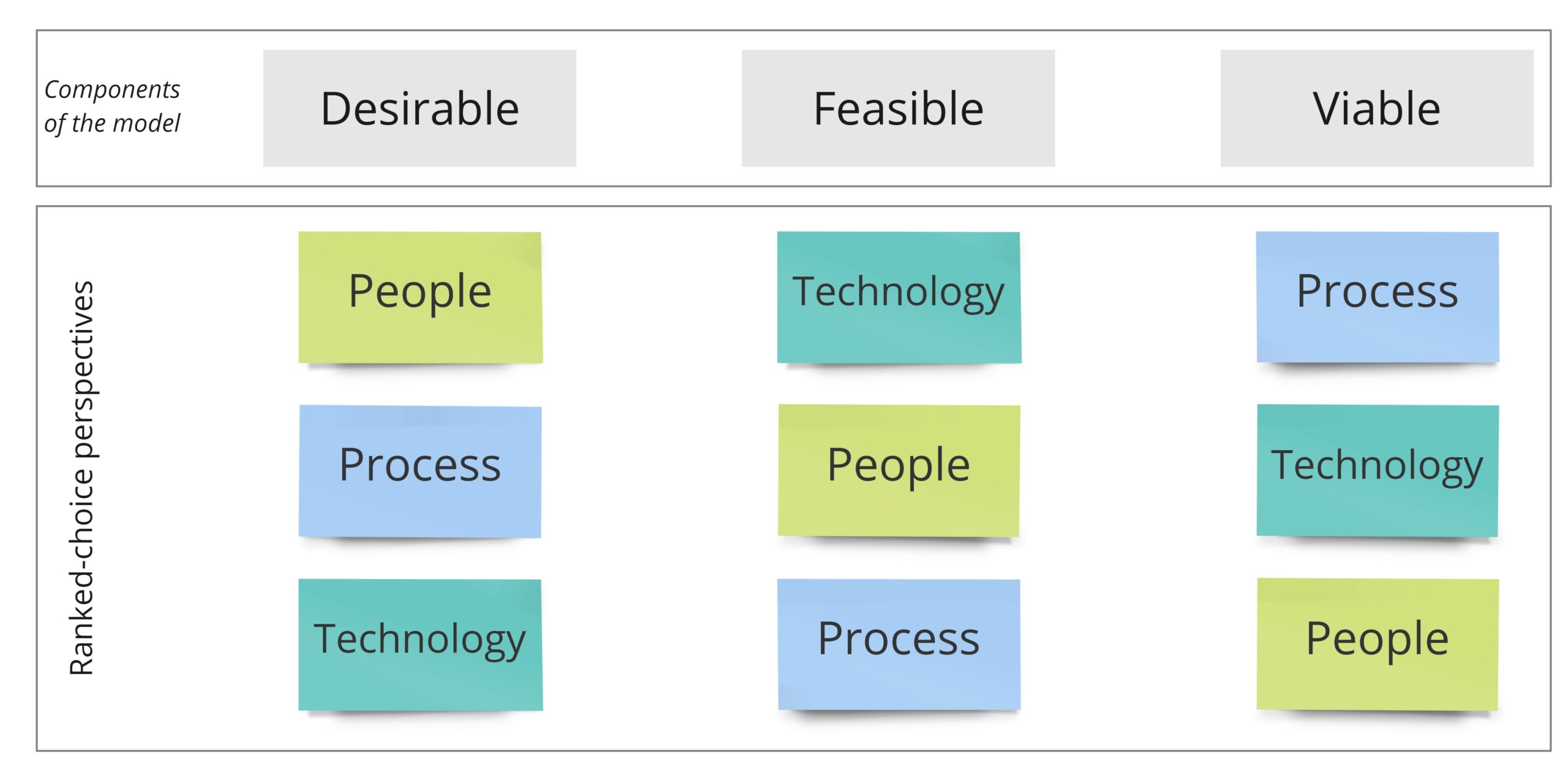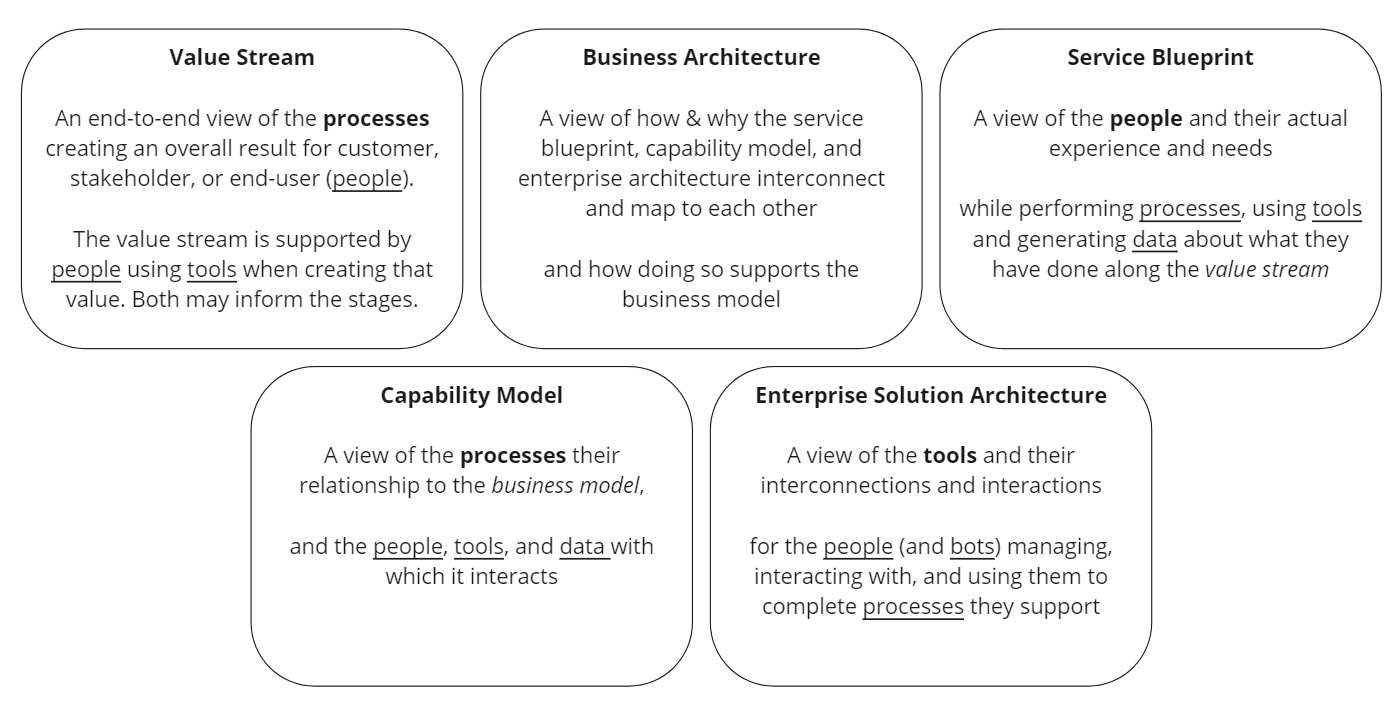Stack Ranked Perspectives
Increasing Understanding With Perspectives
How we each stack rank our principles shapes our perception of our world. To build a better understanding of where we focus, how we each think, and how we approach the work we do together, I like to think about how we each choose to rank the perspectives through we we can understand the world.
What are perspectives?
A perspective is the WHO or the WHAT that describes from where we are observing the world. Imagine picturing a customer’s experience through their own eyes or watching a video from a camera bolted to the top of a piece of machinery.
To start exploring the idea, we’ll describe our world (our system) using the classic trinity of People / Process / Tools as they are concepts with which most are reasonably familiar. 1 For the purposes of exploring their perspectives, they are defined as:
- People is all about the humans that are a part of our system, be they users, employees, leaders, or YOU.
- Process is all about the the steps taken (hopefully towards a goal!).
- Tools are the hammers and nails, the laptops, white boards, and services we use to do … something.

What does it mean to stack rank these perspectives? 2
To stack rank perspectives is to articulate how we value and prioritize the perspectives relative to one another when we are creating a purposeful system. 3
Systems are connected. It is impossible to fully encapsulate any one perspective from the rest and have a view of the world from only one point of view. How good is the work from a development team that never considers how well their tools carry meaning when they communicate with each other? How much value has been destroyed by processes that were designed without consideration of the human-centered perspective from which that process would be experienced?
While we can’t fully encapsulate our system, we can describe which perspectives are the most important for a certain approach, pinning down that variable in such a way that allows us to move forward with confidence yet re-examine from new perspectives in the future.
Illustrating Stack Ranking in Design Thinking
To illustrate how this might work, let’s start with a common design thinking & innovation construct 4 used to validate and shape a product strategy: Desirable – Feasible – Viable, which we’ll define here as:
- Desirable
- Do people want it? Are we solving for the right pain point?
- Feasible
- Is it possible now? Are we building on our core strengths?
- Viable
- Can it continue to work? Does it contribute to long-term growth?
That is okay, but it leaves a lot of nuance and wiggle room on the table. It describes a perspective, but without any context.
Desirable is more than just the people, to understand if it is the right pain point we want to understand the process they are following and ideally the tools they are using along the way.
Feasibility is often immediately thought of in terms of “oh do we have the technology for this?” but it’s equally important that the skills are there to build the crazy idea in the first place.
And even if that crazy idea is built once, what are the processes we need to adapt to make it viable for scale? Or are there new technologies on the horizon that have to come out as well before it can be a sustaining innovation?
Stack Ranked Perspectives for Product Strategy
Following that pattern, we then stack rank those perspectives against those components and here’s what we get:

With this deeper understanding of our priorities for each component, we can refine our definitions with more context:
- Desirable
- First about if people want it while recognizing that the desire will come from current processes or technology limitations.
- Are we solving a pain point they are experiencing with an existing process?
- Are we able to offer new solutions because of technological change?
- First about if people want it while recognizing that the desire will come from current processes or technology limitations.
- Feasible
- First about technology with fast follow consideration of our people and processes.
- Are our ideas at all possible with the technology available today?
- Are we building on the core strengths of our organization, our people, and our business model?
- First about technology with fast follow consideration of our people and processes.
- Viable
- First about our processes including the macro environment, all of which are created by technology and people.
- Can this continue to work? Did we solve for out through brute force today but expect technological advancement to make it reasonable tomorrow?
- Does it contribute to long-term growth? Is it complementary to the skill sets of our people or do our customers associate it with the other aspects of their relationship with us.
- First about our processes including the macro environment, all of which are created by technology and people.
Stack Ranking for Design and Strategy
With me so far? Wondering how this might apply to you? What you do and who you work with? Let’s start by refining the definitions for some common constructs we use to explicitly include and rank these perspectives.

With these definitions, the relationships and differences between these constructs becomes more evident and the connections are interesting.
Connecting Value Streams & Service Blueprints
Let’s play with the perspectives of a value stream and service blueprint.
The value stream is looking first at the processes that are delivering value to the people at the end of the stream along with the people (often as roles, teams, and organizational groups) at each stage of that value stream.
With that in mind, let’s take the service blueprint and put it orthogonal(ish) to the value stream. When created as part of a joint effort, the service blueprint shows the perspective of the people experiencing that value stream, being either a part of or at the end of it. Together they create a model of our world that is better than either alone.
The Service Blueprint Describes Experiences from Value Stream
The importance of having this multi-factor perspective can not be overstated. With the consistency of a common vision and a strong understanding of our perspectives, we can design multiple models of the system such that they relate and create strong feedback loops.
For example, the human experiencing executing processes at a node along the value stream is doing so with a set of tools with certain functionality. More than just checking off a capability box, the frustration from slow, inefficient, or otherwise poorly designed tools can have significant impacts that wouldn’t show up in a pure process flow. Similarly, their understanding of the outcome of the processes they are completing will be limited by what is backstage from their vantage point, limiting their ability to make optimal decisions.
The experience of the humans at the end of the stream will be impacted by what is front stage and what we keep back stage. The tools & technology they use to receive that value are also critical to understand. For example, having the most amazing desktop website doesn’t mean anything to the more than 50% of the world who are now mobile-first.
Stack Ranking Perspectives Describe Trade-offs
The hardest choices we make relate to focus. What do we do? What do we not do? How do we evaluate the opportunity cost and quash our everlasting FOMO? Generate a deeper understanding of your problem space, define your priorities, and communicate how as a team we can build more awesomeness by approaching our vision from multiple perspectives.
Perspectives Series
- Stack Ranking Perspectives
- Perspectives to Relate Design & Strategy (coming shortly)
- … more to come
- Yes, Data belongs in there, too. But let’s get through one new idea at a time.
↩︎
- Another way to think of ranked choice perspectives is like ranked choice voting. As defined by FairVote.org, Ranked choice voting (RCV) describes voting systems that allow voters to rank candidates in order of preference, and then uses those rankings to elect candidates able to combine strong first choice support with the ability to earn second and third choice support. ↩︎
- My favorite definition of design is “The intentional creation of a purposeful system.” ↩︎
- I’m going to use construct throughout instead of methodology, approach, or any of the other myriad words which mean slightly different things to different people. ↩︎


About The Author: Jeremy
More posts by jeremy